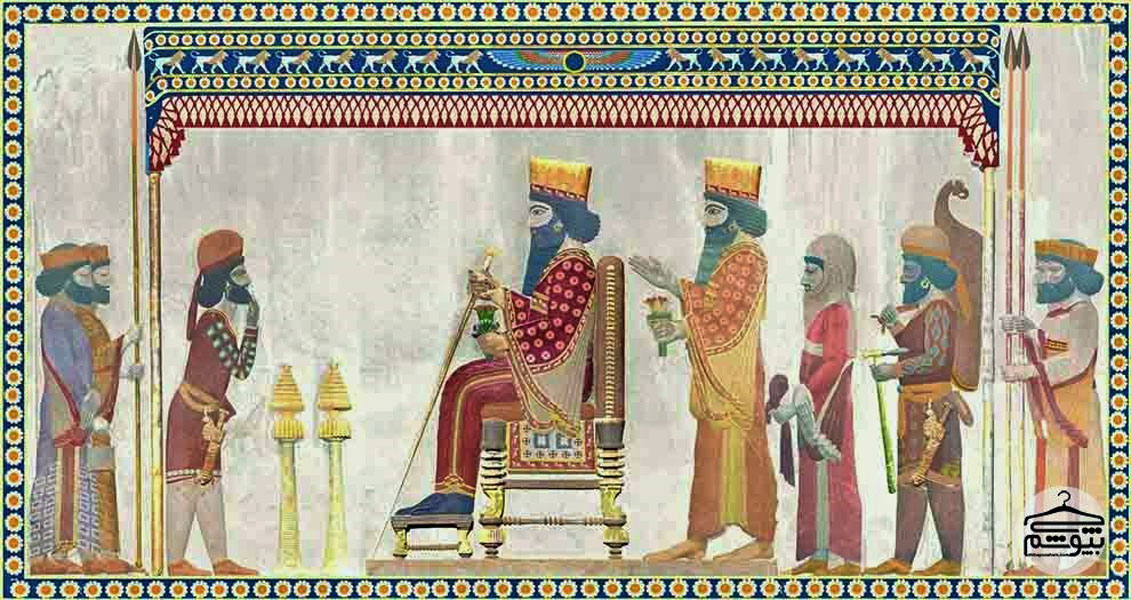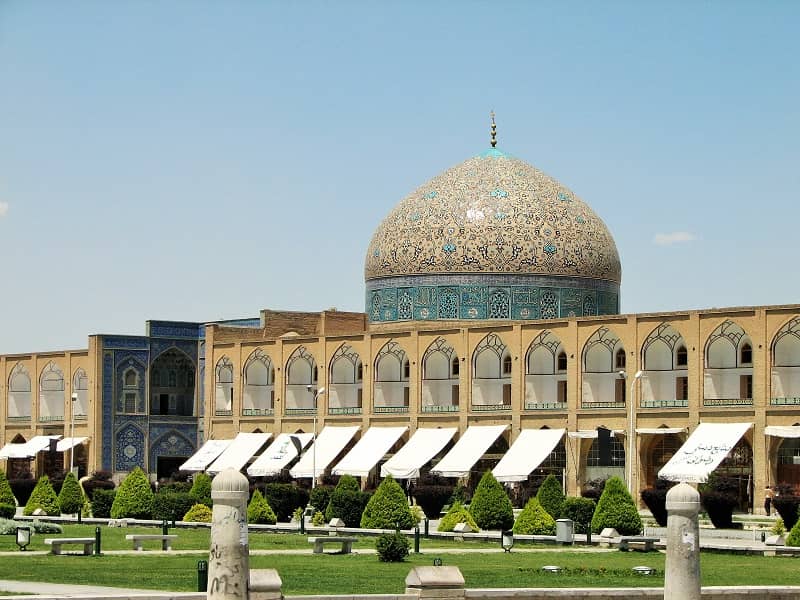
The historical metropolis of Isfahan is known as “half of the world” because of its unique monuments. Since Isfahan was chosen as the capital of the country during the Safavid era, many historical monuments were built there. One of these works is Sheikh Lotfollah Mosque, which has unique features.
This mosque was built during the Safavid era and by the order of Shah Abbas. He built this mosque in the name of his father-in-law (Sheikh Lotfollah) in the first half of the 17th century. The construction of this mosque lasted eighteen years.
Sheikh Lotfollah was one of the great scholars of his time who lived in Jebel Amal, Lebanon. Shah Abbas asked them to immigrate to Iran. After migrating, he first settled in Mashhad and Qazvin and then in Isfahan.
Sheikh Lotfollah was also considered one of the well-known Shiite clerics in his country. Sheikh Lotfollah Mosque was a private place where only the royal family could pray. He believed that during the absence of Imam Mahdi (the 12th Imam of Shiites), it is necessary to perform Friday prayers. Hence, the Friday prayer of the royal family was held in this mosque under his leadership.
From the Entrance of Sheikh Lotfollah Mosque to Its Mehrab
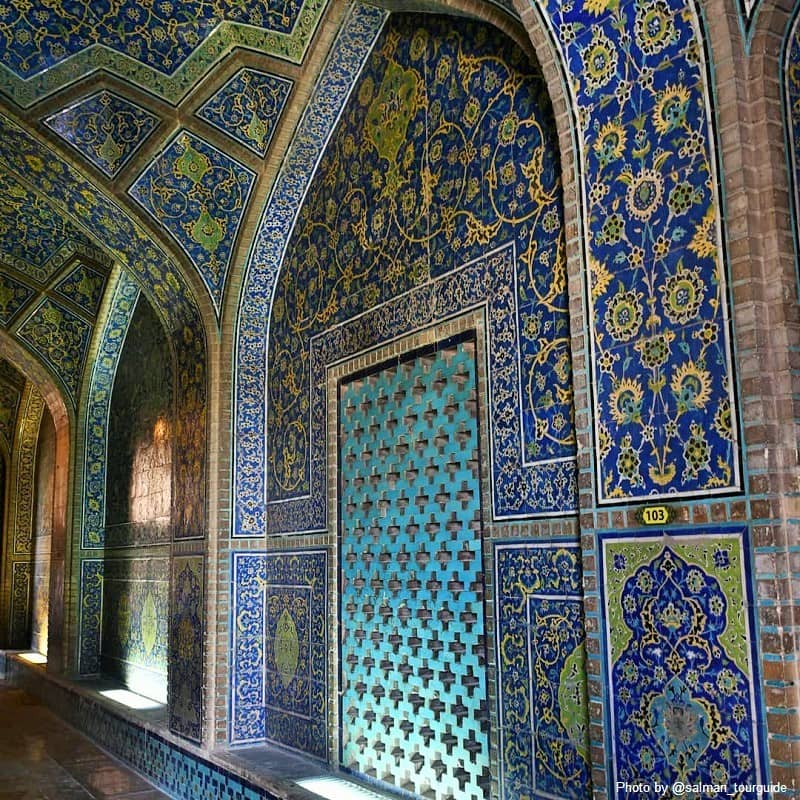
The entrance of Sheikh Lotfollah Mosque has a double door made of plane tree wood. This door is facing east. Since the entrance door is facing east, it would be difficult to find Qibla, so some measures were thought for it.
To solve this problem, a 28-meter-long corridor has been designed and built. This corridor has two turns to the right, which causes the mosque’s mihrab to turn 45 degrees from the north-south axis to the southwest. Finally, the worshiper stands along the mehrab to see the Qiblah. The corridor of the mosque is decorated with tiles of seven colors, most of which are green, blue, and azure.
By passing through the corridor, we reach the interior of the mosque. In this space, the altar of the mosque is visible, which has a beautifully decorated arch. On this altar, they are decorated with arabesque motifs, mosaic tiles, and delicate moqarans works. There are two inscriptions on the altar of the mosque on which the name of the architect is written.
Architectural Features of Sheikh Lotfollah Mosque in Isfahan
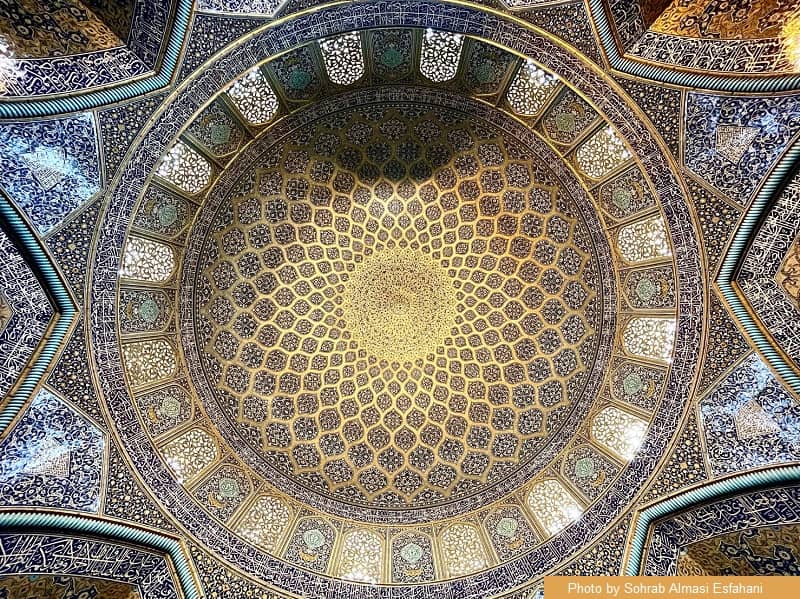
Sheikh Lotfollah Mosque is a one-of-a-kind building and a special monument of the Safavid period. This mosque has unique features, including the following:
1. The Dome of the Mosque
It is one of the distinctive features of this building, being a huge and magnificent dome. This dome is placed on the mosque in such a way that if you look from the outside, a part of it is hidden behind the gate. The height of the top of the dome to the ground level is about 32 meters, its opening is 12 meters, and the outside diameter of the mosque is 22 meters.
The dome of Sheikh Lotfollah Mosque turns into different colors during the day, which is one of its unique features. This dome can be seen in pink color at dawn, cream color at noon, and brick color at sunset. Sometimes, because of this feature, they call Sheikh Lotfollah’s mosque the peacock feather.
The domes built in the Safavid period have a special elegance and elegance. In the field of art, when it comes to elegance, means using technical and precise measures to achieve the beauty of the work of art.
2. Ceiling Decorations and Spiral Columns
The interior of Sheikh Lotfollah Mosque is decorated with 16 mesh windows that bring light inside. These windows are placed at a distance of 170 cm. Mesh windows are placed on top of the mosque arch. The number of 8 gable arches is responsible for maintaining the dome of the mosque. These arches are placed on spiral and turquoise columns. The said columns are decorated with unique turquoise-colored and glazed decorations.
The ceiling of the mosque, which is the inner part of its dome, consists of many rhombuses. The more we go toward the center, the smaller the size of these rhombuses. Together, these rhombuses show the shape of a peacock with its feathers spread out.
To show the beautiful colors, mosaic tiles are used on the ceiling of the mosque. These tiles cover the mosque from the ceiling to the plinth (the lower part of the mosque wall from the floor to the ledge).
3. The Connection between Sheikh Lotfollah Mosque and Ali Qapu Palace
By examining the available evidence, we find a corridor under Naqsh Jahan square. This corridor established the connection between Sheikh Lotfollah Mosque and Ali Qapu Palace. Since Sheikh Lotfollah Mosque was built for the royal family, women were also present in this mosque. They used to come and go inside the mosque through this corridor so as not to appear in public.
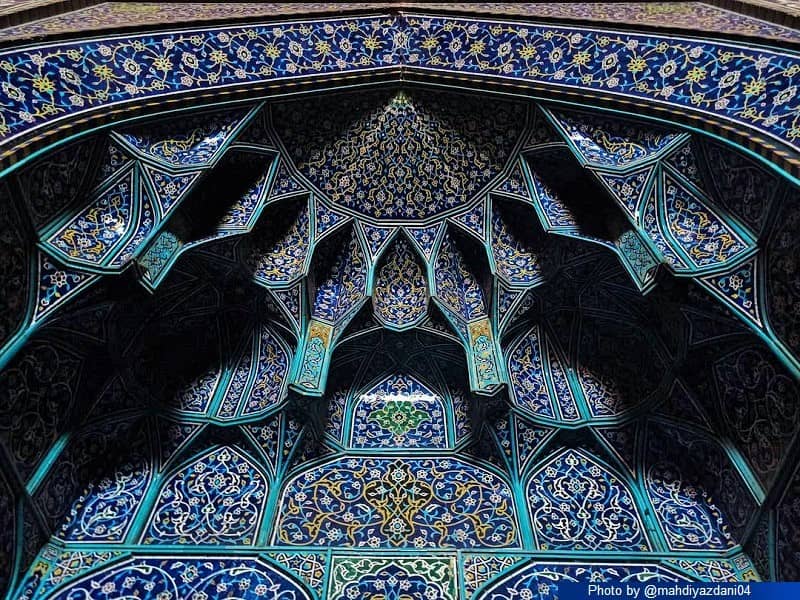
In this mosque, Sheikh Lotfollah used to teach religious issues to women and the royal family. Today, with the construction of a large pond in Naqsh Jahan Square, the connection between the mosque and the Alai Qapu Palace has been cut off.
Does Sheikh Lotfollah Mosque Have a Minaret?
Unlike many mosques that have minarets and courtyards, Sheikh Lotfollah Mosque is an exception to this rule. Mosque minarets are usually built to call people to prayer. Since this mosque was built for Sheikh Lotfollah and the royal family, they chose not to build a minaret for it.
Also, due to the location of Ali Qapu Palace in front of the mosque, there was no space to build a courtyard. As a result, unlike all other mosques, this mosque was built without a courtyard and a minaret.
The Main and Winter Shed of Sheikh Lotfollah Mosque
The Sassanid style of architecture was used in the construction of the main shabestan (prayer hall) of Sheikh Lotfollah Mosque. The design of the shabestan is such that it is seen at first as a square with sides of 19 meters. As the height of the walls increases, their shape changes from a square to an octagon. Finally, reaching the stem of the dome, the shape of the nave changes to a circle.
In addition to that, this mosque also has another shabestan, which was the place of prayer in winter. To reach this Shabestan, at the beginning of the entrance corridor of the mosque, on the right side, there is a door that leads to the lower floor of the building. Sheikh Lotfollah’s winter nativity scene is here, with minimal decorations, but a suitable temperature, which has been a pleasant place for the royal family to pray.
Make Sure You Visit This Attraction
Sheikh Lotfollah Mosque of Isfahan has many unique features, some of which were mentioned in this article. In order to know more features of this monument, you can read books about it, but our recommendation is that you definitely visit it.
If you happen to pass through Isfahan on Iran tours or on your own, be sure to visit Sheikh Lotfollah Mosque. Destination Iran invites you to go through the “tourist attractions of Isfahan“, visit this mosque and explore its unique architecture.






